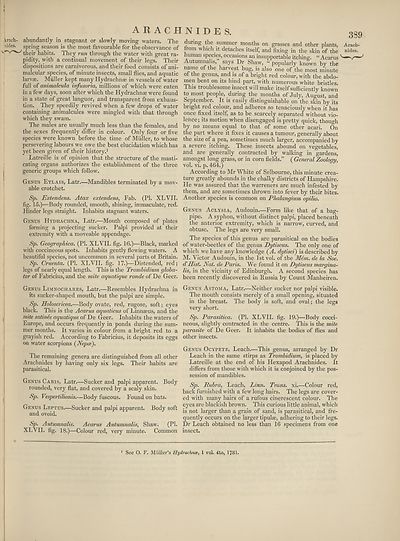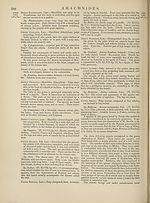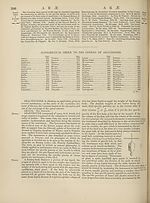Encyclopaedia Britannica > Volume 3, Anatomy-Astronomy
(397) Page 389
Download files
Complete book:
Individual page:
Thumbnail gallery: Grid view | List view

*
ARACHNIDES.
irach- abundantly in stagnant or slowly moving waters. The
aides, spring season is the most favourable for the observance of
their habits. They run through the water with great ra¬
pidity, with a continual movement of their legs. Their
dispositions are carnivorous, and their food consists of ani-
malcular species, of minute insects, small flies, and aquatic
larvae. Muller kept many Hydrachnae in vessels of water
full of animalcula infusoria, millions of which were eaten
in a few days, soon after which the Hydrachnae were found
in a state of great languor, and transparent from exhaus¬
tion. They speedily revived when a few drops of water
containing animalcules were mingled with that through
which they swam.
The males are usually much less than the females, and
the sexes frequently differ in colour. Only four or five
species were known before the time of Muller, to whose
persevering labours we owe the best elucidation which has
yet been given of their history.1
Latreille is of opinion that the structure of the masti¬
cating organs authorizes the establishment of the three
generic groups which follow.
Genus Eylais, Latr—Mandibles terminated by a mov¬
able crotchet.
Sp. Extendens. Atax extendens, Fab. (PI. XLVII.
fig. 15.)—Body rounded, smooth, shining, immaculate, red.
Hinder legs straight. Inhabits stagnant waters.
Genus Hydrachna, Latr.—Mouth composed of plates
forming a projecting sucker. Palpi provided at their
extremity with a moveable appendage.
Sp. Geographica. (PI. XLVII. fig. 16.)—Black, marked
with coccineous spots. Inhabits gently flowing waters. A
beautiful species, not uncommon in several parts of Britain.
Sp. Cruenta. (PI. XLVII. fig. 17.)—Distended, red;
legs of nearly equal length. This is the Trombidium globa-
tor of Fabricius, and the mite aquatique ronde of De Geer.
unng the summer months on grasses and other plants,
from which it detaches itself, and fixing in the skin of the
human species, occasions an insupportable itching. “ Acarus
Autumnahs, says Dr Shaw, “ popularly known by the
name of the harvest bug, is also one of the most minute
of the genus, and is of a bright red colour, with the abdo¬
men bent on its hind part, with numerous white bristles.
This troublesome insect will make itself sufficiently known
to most people, during the months of July, August, and
September. It is easily distinguishable on the skin by its
bright red colour, and adheres so tenaciously when it has
once fixed itself, as to be scarcely separated without vio¬
lence; its motion when disengaged is pretty quick, though
by no means equal to that of some other acari. On
the part where it fixes it causes a tumour, generally about
the size of a pea, sometimes much larger, accompanied by
a severe itching. These insects abound on vegetables,
and are generally contracted by walking in gardens,
amongst long grass, or in corn fields.” ( General Zoology,
vol. vi. p. 464.)
According to Mr White of Selbourne, this minute crea¬
ture greatly abounds in the chalky districts of Hampshire.
He was assured that the warreners are much infested by
them, and are sometimes thrown into fever by their bites.
Another species is common on Phalangium opilio.
Genus Aclysia, Audouin.—Form like that of a bag¬
pipe. A syphon, without distinct palpi, placed beneath
the anterior extremity, which is narrow, curved, and
obtuse. The legs are very small.
The species of this genus are parasitical on the bodies
of water-beetles of the genus Dytiscus. The only one of
which we have any knowledge (A. dytisci) is described by
M. Victor Audouin, in the 1st vol. of the Mem. de la Soc.
d'Hist. Nat. de Paris. We found it on Dytiscus margina-
lis, in the vicinity of Edinburgh. A second species has
been recently discovered in Russia by Count Manheiren.
339
Arach-
nides.
Genus Limnochares, Latr.—Resembles Hydrachna in
its sucker-shaped mouth, but the palpi are simple.
Sp. Holosericea.—Body ovate, red, rugose, soft; eyes
black. This is the Acarus aquaticus of Linnaeus, and the
mite satinee aquatique of De Geer. Inhabits the waters of
Europe, and occurs frequently in ponds during the sum¬
mer months. It varies in colour from a bright red to a
grayish red. According to Fabricius, it deposits its eggs
on water scorpions {Nepce).
The remaining genera are distinguished from all other
Arachnides by having only six legs. Their habits are
parasitical.
Genus Caris, Latr.—Sucker and palpi apparent. Body
rounded, very flat, and covered by a scaly skin.
Sp. Vespertilionis.—Body fuscous. Found on bats.
Genus Leptus.—Sucker and palpi apparent. Body soft
and ovoid.
Sp. Autumnalis. Acarus Aulumnalis, Shaw. (PI.
XLVII. fig. 18.)—Colour red, very minute. Common
Genus Astoma, Latr.—Neither sucker nor palpi visible.
The mouth consists merely of a small opening, situated
in the breast. The body is soft, and oval; the legs
very short.
Sp. Parasitica. (PI. XLVII. fig. 19.)—Body cocci¬
neous, slightly contracted in the centre. This is the mite
parasite of De Geer. It inhabits the bodies of flies and
other insects.
Genus Ocypete, Leach.—This genus, arranged by Dr
Leach in the same stirps as Trombidium, is placed by
Latreille at the end of his Hexapod Arachnides. It
differs from those with which it is conjoined by the pos¬
session of mandibles.
Sp. Rubra, Leach, Linn. Trans, xi.—Colour red,
back furnished with a few long hairs. The legs are cover¬
ed with many hairs of a rufous cinerescent colour. The
eyes are blackish brown. This curious little animal, which
is not larger than a grain of sand, is parasitical, and fre¬
quently occurs on the larger tipulae, adhering to their legs.
Dr Leach obtained no less than 16 specimens from one
insect.
See O. F. Muller’s Hydrachnae, 1 vol. 4to, 1781.
ARACHNIDES.
irach- abundantly in stagnant or slowly moving waters. The
aides, spring season is the most favourable for the observance of
their habits. They run through the water with great ra¬
pidity, with a continual movement of their legs. Their
dispositions are carnivorous, and their food consists of ani-
malcular species, of minute insects, small flies, and aquatic
larvae. Muller kept many Hydrachnae in vessels of water
full of animalcula infusoria, millions of which were eaten
in a few days, soon after which the Hydrachnae were found
in a state of great languor, and transparent from exhaus¬
tion. They speedily revived when a few drops of water
containing animalcules were mingled with that through
which they swam.
The males are usually much less than the females, and
the sexes frequently differ in colour. Only four or five
species were known before the time of Muller, to whose
persevering labours we owe the best elucidation which has
yet been given of their history.1
Latreille is of opinion that the structure of the masti¬
cating organs authorizes the establishment of the three
generic groups which follow.
Genus Eylais, Latr—Mandibles terminated by a mov¬
able crotchet.
Sp. Extendens. Atax extendens, Fab. (PI. XLVII.
fig. 15.)—Body rounded, smooth, shining, immaculate, red.
Hinder legs straight. Inhabits stagnant waters.
Genus Hydrachna, Latr.—Mouth composed of plates
forming a projecting sucker. Palpi provided at their
extremity with a moveable appendage.
Sp. Geographica. (PI. XLVII. fig. 16.)—Black, marked
with coccineous spots. Inhabits gently flowing waters. A
beautiful species, not uncommon in several parts of Britain.
Sp. Cruenta. (PI. XLVII. fig. 17.)—Distended, red;
legs of nearly equal length. This is the Trombidium globa-
tor of Fabricius, and the mite aquatique ronde of De Geer.
unng the summer months on grasses and other plants,
from which it detaches itself, and fixing in the skin of the
human species, occasions an insupportable itching. “ Acarus
Autumnahs, says Dr Shaw, “ popularly known by the
name of the harvest bug, is also one of the most minute
of the genus, and is of a bright red colour, with the abdo¬
men bent on its hind part, with numerous white bristles.
This troublesome insect will make itself sufficiently known
to most people, during the months of July, August, and
September. It is easily distinguishable on the skin by its
bright red colour, and adheres so tenaciously when it has
once fixed itself, as to be scarcely separated without vio¬
lence; its motion when disengaged is pretty quick, though
by no means equal to that of some other acari. On
the part where it fixes it causes a tumour, generally about
the size of a pea, sometimes much larger, accompanied by
a severe itching. These insects abound on vegetables,
and are generally contracted by walking in gardens,
amongst long grass, or in corn fields.” ( General Zoology,
vol. vi. p. 464.)
According to Mr White of Selbourne, this minute crea¬
ture greatly abounds in the chalky districts of Hampshire.
He was assured that the warreners are much infested by
them, and are sometimes thrown into fever by their bites.
Another species is common on Phalangium opilio.
Genus Aclysia, Audouin.—Form like that of a bag¬
pipe. A syphon, without distinct palpi, placed beneath
the anterior extremity, which is narrow, curved, and
obtuse. The legs are very small.
The species of this genus are parasitical on the bodies
of water-beetles of the genus Dytiscus. The only one of
which we have any knowledge (A. dytisci) is described by
M. Victor Audouin, in the 1st vol. of the Mem. de la Soc.
d'Hist. Nat. de Paris. We found it on Dytiscus margina-
lis, in the vicinity of Edinburgh. A second species has
been recently discovered in Russia by Count Manheiren.
339
Arach-
nides.
Genus Limnochares, Latr.—Resembles Hydrachna in
its sucker-shaped mouth, but the palpi are simple.
Sp. Holosericea.—Body ovate, red, rugose, soft; eyes
black. This is the Acarus aquaticus of Linnaeus, and the
mite satinee aquatique of De Geer. Inhabits the waters of
Europe, and occurs frequently in ponds during the sum¬
mer months. It varies in colour from a bright red to a
grayish red. According to Fabricius, it deposits its eggs
on water scorpions {Nepce).
The remaining genera are distinguished from all other
Arachnides by having only six legs. Their habits are
parasitical.
Genus Caris, Latr.—Sucker and palpi apparent. Body
rounded, very flat, and covered by a scaly skin.
Sp. Vespertilionis.—Body fuscous. Found on bats.
Genus Leptus.—Sucker and palpi apparent. Body soft
and ovoid.
Sp. Autumnalis. Acarus Aulumnalis, Shaw. (PI.
XLVII. fig. 18.)—Colour red, very minute. Common
Genus Astoma, Latr.—Neither sucker nor palpi visible.
The mouth consists merely of a small opening, situated
in the breast. The body is soft, and oval; the legs
very short.
Sp. Parasitica. (PI. XLVII. fig. 19.)—Body cocci¬
neous, slightly contracted in the centre. This is the mite
parasite of De Geer. It inhabits the bodies of flies and
other insects.
Genus Ocypete, Leach.—This genus, arranged by Dr
Leach in the same stirps as Trombidium, is placed by
Latreille at the end of his Hexapod Arachnides. It
differs from those with which it is conjoined by the pos¬
session of mandibles.
Sp. Rubra, Leach, Linn. Trans, xi.—Colour red,
back furnished with a few long hairs. The legs are cover¬
ed with many hairs of a rufous cinerescent colour. The
eyes are blackish brown. This curious little animal, which
is not larger than a grain of sand, is parasitical, and fre¬
quently occurs on the larger tipulae, adhering to their legs.
Dr Leach obtained no less than 16 specimens from one
insect.
See O. F. Muller’s Hydrachnae, 1 vol. 4to, 1781.
Set display mode to:
![]() Universal Viewer |
Universal Viewer | ![]() Mirador |
Large image | Transcription
Mirador |
Large image | Transcription
Images and transcriptions on this page, including medium image downloads, may be used under the Creative Commons Attribution 4.0 International Licence unless otherwise stated. ![]()
| Encyclopaedia Britannica > Encyclopaedia Britannica > Volume 3, Anatomy-Astronomy > (397) Page 389 |
|---|
| Permanent URL | https://digital.nls.uk/193762509 |
|---|
| Attribution and copyright: |
|
|---|---|
| Shelfmark | EB.16 |
|---|---|
| Description | Ten editions of 'Encyclopaedia Britannica', issued from 1768-1903, in 231 volumes. Originally issued in 100 weekly parts (3 volumes) between 1768 and 1771 by publishers: Colin Macfarquhar and Andrew Bell (Edinburgh); editor: William Smellie: engraver: Andrew Bell. Expanded editions in the 19th century featured more volumes and contributions from leading experts in their fields. Managed and published in Edinburgh up to the 9th edition (25 volumes, from 1875-1889); the 10th edition (1902-1903) re-issued the 9th edition, with 11 supplementary volumes. |
|---|---|
| Additional NLS resources: |
|

